In an era of shrinking newsrooms and misinformation, the SOJC overhauled its journalism program to confront rapid changes in the news industry.

by Julia Boboc, class of ’26
When the COVID-19 pandemic shut down the country in 2020, Allen Hall went quiet. Students, faculty and staff were backed into the corner of online learning, asynchronous classes and an uncertain world.
Associate Dean for Undergraduate Affairs Deb Morrison said the pandemic also forced the UO School of Journalism and Communication (SOJC) faculty and administration to rethink its structures and motivations. If the world could change in an instant, the SOJC needed to be ready to face any disruption ahead.
The state of journalism was undergoing a massive transformation. Misinformation about the COVID-19 virus and vaccine was spreading like wildfire while mainstream media outlets were being demonized by conspiracy theorists and even the president himself. Local news outlets were shrinking, the American people were losing trust in the press and social media was misleading the public at a rate journalism could not keep up with.
Morrison felt a question burning in her mind: “What are we doing? And why are we doing it?”
The old model of journalism was being picked apart, while journalism schools — including the SOJC — were stuck in place.
“Do we go back to the same old rhythm?” Morrison remembers thinking at the time. No. “Everybody knew something had to change.”
Three years later, that change came in the form of a revamped journalism curriculum with reworked and completely new courses, and new ways of thinking about journalism education.
The new journalism curriculum aims to better prepare students for their careers by teaching them about the inner workings of the industry and the structure of modern newsrooms.
Smaller class sizes give students more opportunities for one-on-one instruction from professors and more time to find their passions and get involved with them, while revamped courses aim to teach about journalism’s present structure and where it’s going in the future.
Expanding the fundamentals of journalism
Journalism and media studies instructor Charlie Deitz teaches many of the prerequisite classes in the journalism program. For him, the big change wasn’t just class material. It was the opportunity to expand on the “tools we’ve been teaching with already,” tools like the inverted pyramid, the narrative arc and the ladder of abstraction.
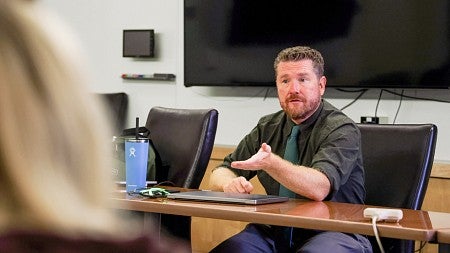
With more class time, professors like Deitz can dive deeper into the way these tools work in stories, and how to use them creatively.
“If we’re lacking in our fundamental skills, how are we going to go out and break a story where we’re actually challenging a mayor, challenging a city council, or understanding how this policy affects Black people in this particular neighborhood?” Deitz asked. “If you want to go out and do the journalism, you gotta hit the ground running, and your editors have to see something in you so you can tell those big stories.”
The curriculum change also streamlined the major requirements, getting students through their prerequisites with a better understanding of the basic skills needed to succeed in the industry.
To do that, the curriculum minimized the prerequisite classes and combined some courses to reduce redundancy, like Writing for Communicators and Grammar for Communicators. By melding the two classes, students can explore a wider variety of topics in their first two years.
That allows students to take higher-level classes more quickly, Morrison said. The big step in that direction was dismantling one of the most notorious classes in the journalism curriculum.
Goodbye Gateway, hello Story Craft
J211: Gateway to Media was a staple prerequisite class in the SOJC curriculum for over a decade. The eight-credit, four-day-a-week, intensive multimedia lecture introduced students to writing, photography, audio and video production.
Every student in the SOJC had to get through Gateway before splitting off into their major-specific courses. Some students loved the hands-on nature, but many dreaded the intensity of the class.
Each class had about 200 students who created four stories, one in each format, using the basic skills and software taught in the class.
Deitz taught Gateway for three years and worked as a graduate employee for the class for five years while getting his Ph.D. at the SOJC. He said Gateway worked economically. The class’ large lecture structure saved time, money and resources, but it also sacrificed the professor-student relationship.
“It was good in design, because it's like, how do we get these four threads of multimedia to as many students as possible?” Deitz said. “Students don’t like to feel like one of 1,000, right? Everybody wants to be special. One of 20 or 40 is way better than one of 200 or 150.”
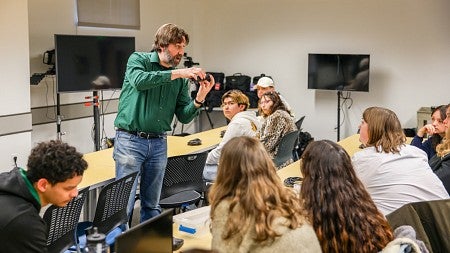
With that in mind, the Story Craft curriculum pathway was born.
Morrison and other staff members brainstormed a plan to split Gateway into four smaller classes: How Stories Work, Story Craft Audio, Story Craft Visual and Writing as Practice.
The intro is How Stories Work. In the fast-paced environment of Gateway, Morrison realized there wasn’t a lot of conversation about planning stories and storyboarding.
“A big thing is making sure that students think of themselves as creators and not just consumers,” Morrison said. “That was implicit in Gateway, but now we’re taking it out and really building that.”
In How Stories Work, students approach their stories more methodically and plan them out in more detail before beginning production.
Once the stories are planned, it’s time to bring them to life.
Enter Story Craft Audio, Story Craft Visual and Writing as Practice.
For many students, Gateway offered their first opportunity to check out equipment and use it to tell a story. Story Craft retains those hands-on opportunities by giving students more time to get acquainted with the equipment and the storytelling process.
As two-credit, half-term classes, Story Craft Audio and Story Craft Visual answer questions like, “What do you have available, specifically in the SOJC, but also in the world, to do a great audio story? What do you need to know? What are the sound levels?” Morrison said. “Gateway didn’t have time to go into that detail.”
The last step of the Gateway revamp was to combine the written portion of the class with the SOJC’s introductory writing lectures to create Writing as Practice. This class has smaller class sizes than its predecessor, providing more one-on-one time with professors to discuss the writing process and get more feedback on their work.
Morrison said she’s received positive feedback about the curriculum changes, and the Story Craft pathway is becoming one of the most well-liked additions.
“Students really reacted well to How Stories Work and Writing as Practice,” Morrison said. “They enjoy smaller classes and they enjoy getting to do this deep thinking. And they loved Story Craft. I’ve only heard good things.”
Blowing up the J-school model
Revamping the curriculum did not happen overnight. It took months of research and discourse to create a curriculum that would meet the SOJC’s goals, Morrison said.
First, SOJC faculty and staff looked at other institutions’ approaches to teaching journalism. They looked at interesting classes and how other universities’ curricula had changed over the past couple of decades.
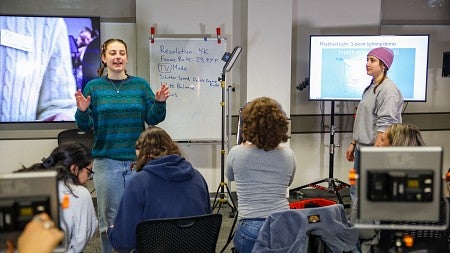
The truth is, Morrison said, most hadn’t changed much. A lot of universities were still offering the same classes they had for decades even though journalism was quickly evolving outside the university setting.
And for that reason, she was determined to do something innovative here at the SOJC. Even though it would be hard on professors, staff members, advisors and students, Morrison said it was necessary to make dramatic changes to reflect the evolution happening in newsrooms around the globe.
Many class shifts looked to ease the transition between school and the field, including Deitz’s Reporting I class, which went from being taught twice a week to four times a week.
The increased class time allowed Deitz to emulate the newsroom rhythm, where journalists are assigned pieces every day and expected to turn them around on deadline. It’s more work for Deitz and his students, but it lets him do something he’s wanted to do for a while: making assignments due Friday instead of Sunday.
“People were weird about it,” he said, “but it’s like, ‘No, man, treat it like a job. You work hard throughout the week, you get done Friday, and I’ll see you Monday morning. Your weekend’s your weekend.’”
Preparing for life after college
Professors pitched classes they believed would prepare students for the environment outside of the SOJC.
Professor of Practice Damian Radcliffe reached out to former students and colleagues in the field. He sent out a survey to alumni and emailed employers to ask them what they thought SOJC students should learn.
“What did we do? What did we not do? What do you know now that you wish you’d known when you were in Allen Hall?” he asked. The answers varied and offered insight into the SOJC’s pedagogical approach.
Employers mentioned that SOJC students had a good grasp of the basics of their crafts. Students felt they were well acquainted with equipment and well connected with people in the industry.
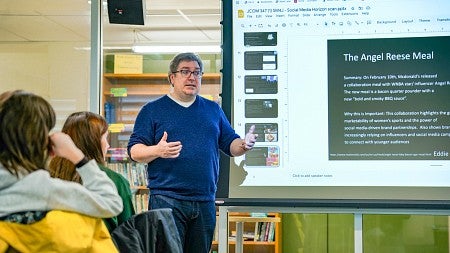
At the same time, some alumni felt like they hadn’t learned enough about their career options after graduation. They hadn’t learned how to approach freelancing or contract work.
Radcliffe talked to one former student about what was important for journalism schools to teach right now.
“They said, ‘You need to understand how your creativity is paid for,’” Radcliffe recalled.
He also heard back from alumni who had found careers outside of journalism, but continue to use the skills they learned in the SOJC.
Radcliffe incorporated the findings from his outreach into discussions around the curriculum change and in meetings with other professors and administration.
“It’s been a lot of work — a lot of committees, a lot of discussion about purposes, a lot of work developing new syllabi and new classes and doing that while still teaching,” Radcliffe said. “But we believe in the value of this stuff. There are quite a lot of classes that people have wanted to do for a long time.”
When Radcliffe joined the SOJC in 2015, he pitched a business of media class. A decade later, he’s finally getting ready to teach it.
The class, which will be offered fall term, will be a prerequisite lecture for all SOJC majors and aims to provide students with knowledge of the business side of journalism and communication. The class will focus on how journalism is funded, the strategies related to audience and creativity, and how the field is changing in the face of social media and entrepreneurship.
In the class, Radcliffe hopes to incorporate his extensive research and expertise in digital media trends and the journalism and communication industry.
“Most of the research work that I do, I don’t get to teach in the classroom,” Radcliffe said. “It was interesting to also think about how I could bring that work into the classroom.”
And, Radcliffe said, the Business of Media class looks to meet the journalism and communication fields where they're at and predict where they will go in the future to keep students at the forefront.
Engaging with the news industry
Professor and James N. Wallace Chair of Journalism Peter Laufer has watched journalism evolve for decades. He said SOJC faculty have long discussed curriculum changes, but this overhaul has been monumental.
For Laufer, this change has shown that the SOJC is committed to innovation and moving forward. But the core fundamentals, like ethics, public affairs, press freedom and communication law, still underpin everything, he said.
After understanding journalism’s role in society, Laufer said students can begin forming their specializations, whether that’s photography, sports, science communication, documentary filmmaking, broadcast or something else.
Prioritizing innovation and modernization is a healthy way to approach journalism. “How do we do that?” Laufer asked. “Well, we’re constantly engaged with industry. We’re, in theory, a think tank; we’re looking toward what could be. Then, if we’re doing our job right, we’re looking to students.”
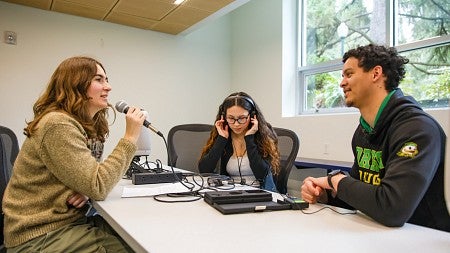
Laufer’s Public Affairs Journalism class, formerly Reporting II, looks to do just that: put the ball in students’ court. By showing them where journalism has come from and where it’s going, Laufer can send students into the field to interact with journalism in its current form and push it further.
The SOJC and its classes are “living and breathing,” Laufer said. They represent the impact and structure of journalism in the outside world. As the roles and dynamics of journalists in society change, so should the SOJC, Laufer said.
“What we’re trying to achieve when we add this class and take that class out is maintaining not just relevancy, but being the advanced guard, so that we are participatory in industry,” Laufer said. And in doing so, he said the SOJC can also contribute to the world of journalism through their research and output.
The conversations around where journalism is going and how the SOJC can represent it will never stop.
Morrison said this school year “is our year … to experiment and to think through and to debrief.”
For Laufer, the discussions and debriefs have been some of his favorite moments throughout the process.
“It helped us continue to build our community as professors within the school. The meetings, the brainstorming, the working out the details brought us together in a different way, which was potent,” he said. “I think that's been very healthy.”
And for Morrison, it’s back to the drawing board at the end of the year. After all the insightful feedback she’s gotten since the curriculum change, she’s only coming up with more ideas to make the SOJC better.
“There’s an added feeling of excitement,” Morrison said. Students and faculty sometimes stop by her office to tell her about the class they’re taking or teaching. Some students have told her they had finally found out what their passion is in journalism, and hearing comments like that has made all the time and effort worthwhile.
“It’s the people,” she said. “That’s what I’m digging the most.”
Julia Boboc is a third-year journalism major in the UO School of Journalism and Communication and a member of Clark Honors College. She especially enjoys interviewing and writing profiles and feels everyone has a story to tell. She is also the host and editor of the SOJC’s “One Cool Story” podcast and the president of the SOJC’s Audio Club and enjoys exploring audio storytelling techniques.
